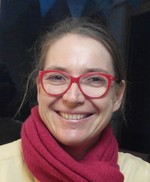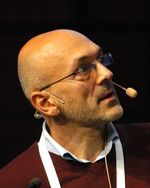Tutoriel 1 : Stéganographie et stéganalyse appliquées aux images numériques
Ce tutoriel détaillera comment insérer une information secrète dans une image (principe de la stéganographie) mais aussi comment la détecter (principe de la stéganalyse). Une fois la terminologie précisée, les différentes classes de schéma d’insertion seront présentées, ainsi que les méthodes de codage associées pour ensuite décrire les méthodes de stéganographie adaptatives les plus populaires. Dans une deuxième partie, les métriques associées à la stéganalyse, ainsi que les différentes méthodologies, seront détaillées.
 Patrick Bas a obtenu le diplôme d'ingénieur en électricité de l'Institut National Polytechnique de Grenoble, France, en 1997, et le doctorat en traitement du signal et des images de l'Institut National Polytechnique de Grenoble, France, en 2000.
Patrick Bas a obtenu le diplôme d'ingénieur en électricité de l'Institut National Polytechnique de Grenoble, France, en 1997, et le doctorat en traitement du signal et des images de l'Institut National Polytechnique de Grenoble, France, en 2000.
De 1997 à 2000, il a été membre du Laboratoire des Images et des Signaux de Grenoble (LIS), France, où il a travaillé sur le tatouage des images fixes. Pendant ses activités postdoctorales, il a été membre du Laboratoire de Communications et de Télédétection de la Faculté d'Ingénierie de l'Université Catholique de Louvain, Belgique. De 2001 à 2009, il a travaillé comme chercheur CNRS au Gipsa-Lab, et depuis 2010, il travaille au CRIStAL, Lille, France.
Ses intérêts de recherche comprennent la synchronisation et l'évaluation de la sécurité dans le filigrane, et la stéganalyse. Il a co-organisé le 9ème workshop international sur la dissimulation d'information (IH07), la 2ème édition du concours Bows-2 sur le tatouage en 2007, et la première édition du concours BOSS sur la stéganalyse en 2010.
Patrick Bas est éditeur associé de IEEE Transactions of Information Forensics and Security (IEEE TIFS). Patrick Bas est l'actuel responsable de l'équipe Signaux Modèles et Applications au sein du laboratoire CRISTAL.
Tutoriel 2 : Explainable AI in the context of computer vision
The recent growth in AI adoption has been driven by the development of deep neural networks and the accuracy of their predictions. However, the underlying mechanisms of AI models are often opaque, leading to issues with fairness, accountability, and transparency. This "black box problem" reduces users' trust in the models. The field of Explainable Artificial Intelligence (XAI) aims to make AI predictions comprehensible and trustworthy, ensuring legal compliance and increasing model reliability by describing the expected impact and potential biases. This tutorial on Explainable AI will focus on the domain of computer vision and explore the concept of Counterfactual Explanations.
 Frédéric Jurie is a full Professor at the University of Caen Normandy, having previously worked as a researcher at the French Centre National de la Recherche Scientifique (CNRS) from 1994 to 2004 at UMR LASMEA in Clermont-Ferrand, and then at the INRIA Rhône-Alpes center affiliated with Cordelia Schmid's research group from 2004 to 2007. He holds a PhD in machine learning and computer vision and has authored or co-authored over 30 articles in international journals and over 140 papers in international conferences. Frédéric Jurie served as the deputy director and later as the director of the GREYC research laboratory from 2012 to 2019. Since 2019, he holds a chair in Artificial Intelligence and worked within the Safran group from 2019 to 2022. Frédéric Jurie's research focuses on Computer Vision and Machine Learning, specifically on the interpretation of images and videos, including image recognition, image classification, and object detection in images. He has been Associate Editor for IJCV and CVIU journals. He has served as Associate Editor for the International Journal of Computer Vision and the Computer Vision and Image Understanding journals.
Frédéric Jurie is a full Professor at the University of Caen Normandy, having previously worked as a researcher at the French Centre National de la Recherche Scientifique (CNRS) from 1994 to 2004 at UMR LASMEA in Clermont-Ferrand, and then at the INRIA Rhône-Alpes center affiliated with Cordelia Schmid's research group from 2004 to 2007. He holds a PhD in machine learning and computer vision and has authored or co-authored over 30 articles in international journals and over 140 papers in international conferences. Frédéric Jurie served as the deputy director and later as the director of the GREYC research laboratory from 2012 to 2019. Since 2019, he holds a chair in Artificial Intelligence and worked within the Safran group from 2019 to 2022. Frédéric Jurie's research focuses on Computer Vision and Machine Learning, specifically on the interpretation of images and videos, including image recognition, image classification, and object detection in images. He has been Associate Editor for IJCV and CVIU journals. He has served as Associate Editor for the International Journal of Computer Vision and the Computer Vision and Image Understanding journals.
Tutoriel 3 : Principes fondamentaux de la compression image et vidéo, et quelques mots sur le « green coding »
Ce tutoriel a pour objectif de donner les principes de base de la compression d’images et de vidéos classique. Les approches par apprentissage ne seront pas abordées. On verra en particulier comment réduire les redondances statistiques grâce au codage statistique (notion d’entropie de Shannon, codage de Huffman, codage arithmétique), les redondances spatiales grâce aux transformées (DCT, ondelettes) ou à la prédiction spatiale (DPCM), et les redondances temporelles par l’estimation-compensation de mouvement. On abordera ainsi les éléments fondamentaux d’un codec hybride de type HEVC. Pour ouvrir vers le futur de la compression vidéo, on verra brièvement quels sont les leviers pour aller vers le « green coding » ou comment concevoir des codecs vidéos plus sobres en consommation d’énergie.
 Luce Morin est Professeure au département EII de l’INSA Rennes et membre de l’équipe de recherche VAADER du laboratoire IETR, UMR-CNRS 6164. Elle a été diplômée de l’ENSPS (à présent Telecom Physique Strasbourg) et a obtenu le DEA Traitements Graphiques Traitement d’Images de l’Université de Strasbourg en 1989. Elle a effectué sa thèse à l’INP Grenoble, dans l’équipe MOVI du laboratoire LIFIA, avec le professeur Roger Mohr, sur le thème des invariants projectifs pour la vision par ordinateur. De 1993 à 2008, elle a été Maitresse de Conférences à l’IFSIC, Université de Rennes 1 et membre de l’équipe Temis, puis Temics de l’IRISA et INRIA Rennes. Depuis 2008, elle est Professeure à l’INSA Rennes et membre du laboratoire IETR. Elle a été la responsable de l’équipe de recherche VAADER de 2015 à 2020. Elle effectue ses recherches dans le domaine de la vision par ordinateur et de la représentation et compression de vidéos 2D, 3D et multi-vues.
Luce Morin est Professeure au département EII de l’INSA Rennes et membre de l’équipe de recherche VAADER du laboratoire IETR, UMR-CNRS 6164. Elle a été diplômée de l’ENSPS (à présent Telecom Physique Strasbourg) et a obtenu le DEA Traitements Graphiques Traitement d’Images de l’Université de Strasbourg en 1989. Elle a effectué sa thèse à l’INP Grenoble, dans l’équipe MOVI du laboratoire LIFIA, avec le professeur Roger Mohr, sur le thème des invariants projectifs pour la vision par ordinateur. De 1993 à 2008, elle a été Maitresse de Conférences à l’IFSIC, Université de Rennes 1 et membre de l’équipe Temis, puis Temics de l’IRISA et INRIA Rennes. Depuis 2008, elle est Professeure à l’INSA Rennes et membre du laboratoire IETR. Elle a été la responsable de l’équipe de recherche VAADER de 2015 à 2020. Elle effectue ses recherches dans le domaine de la vision par ordinateur et de la représentation et compression de vidéos 2D, 3D et multi-vues.
Tutoriel 4 : 3D Geometric Deep Learning
The regular pixel structure of images constitute an ideal support for the application of deep learning solutions that have shown extremely effective results in a variegated set of tasks that go from image classification and recognition to generation. The extension of such techniques to non-regular and non-linear domains, like those represented by graphs, meshes, or point clouds is less obvious. This tutorial will focus on deep learning solutions specifically tailored for data that lie on non-Euclidean domains: first, the different contexts where such data naturally arise will be presented; then, the most successful techniques that have been developed for 3D meshes, point clouds, and non-linear manifolds will be explored.
 Stefano Berretti is an Associate Professor at the Media Integration and Communication Center and at the Dept. of Information Engineering of the Univ. of Florence, Italy. In 2017, he got the habilitation as full Professor in Computer Engineering. His research interests are in the areas of Computer Vision, Artificial Intelligence and Multimedia; on these themes he published more than 200 journals and conference papers. His early scientific contributions focused on efficient methods for image retrieval based on color, shape and spatial relationships. He also contributed to the field of 3D object retrieval and partitioning, face biometrics (from 2D and 3D data), facial expression and emotion recognition (from 3D and 3D dynamic data), human action recognition from depth data, and 3D surface descriptors for relief patterns classification. More recently, he proposed deep learning solutions for face and body analysis and generation, with extension to non-Euclidean domains, like graphs, meshes, and manifolds. He has been the Information Director of the ACM Trans. on Multimedia Computing, Communications, and Applications (ACM TOMM), and he is now an Associate Editor for ACM TOMM, IEEE Trans. on Circuits and Systems for Video Technology, the IET Computer Vision Journal and the Mdpi Sensors journal. He organized special issues in ACM TOMM, IEEE J-BHI, CAG Elsevier, IEEE TII, IEEE Intelligent Systems, ACM TALLIP, and he is a co-editor of the IET International Book Series on Multimedia Information Processing and Security. He has been general chair, program chair and area chair of several international conferences and workshops.
Stefano Berretti is an Associate Professor at the Media Integration and Communication Center and at the Dept. of Information Engineering of the Univ. of Florence, Italy. In 2017, he got the habilitation as full Professor in Computer Engineering. His research interests are in the areas of Computer Vision, Artificial Intelligence and Multimedia; on these themes he published more than 200 journals and conference papers. His early scientific contributions focused on efficient methods for image retrieval based on color, shape and spatial relationships. He also contributed to the field of 3D object retrieval and partitioning, face biometrics (from 2D and 3D data), facial expression and emotion recognition (from 3D and 3D dynamic data), human action recognition from depth data, and 3D surface descriptors for relief patterns classification. More recently, he proposed deep learning solutions for face and body analysis and generation, with extension to non-Euclidean domains, like graphs, meshes, and manifolds. He has been the Information Director of the ACM Trans. on Multimedia Computing, Communications, and Applications (ACM TOMM), and he is now an Associate Editor for ACM TOMM, IEEE Trans. on Circuits and Systems for Video Technology, the IET Computer Vision Journal and the Mdpi Sensors journal. He organized special issues in ACM TOMM, IEEE J-BHI, CAG Elsevier, IEEE TII, IEEE Intelligent Systems, ACM TALLIP, and he is a co-editor of the IET International Book Series on Multimedia Information Processing and Security. He has been general chair, program chair and area chair of several international conferences and workshops.



 Frédéric Jurie is a full Professor at the University of Caen Normandy, having previously worked as a researcher at the French Centre National de la Recherche Scientifique (CNRS) from 1994 to 2004 at UMR LASMEA in Clermont-Ferrand, and then at the INRIA Rhône-Alpes center affiliated with Cordelia Schmid's research group from 2004 to 2007. He holds a PhD in machine learning and computer vision and has authored or co-authored over 30 articles in international journals and over 140 papers in international conferences. Frédéric Jurie served as the deputy director and later as the director of the GREYC research laboratory from 2012 to 2019. Since 2019, he holds a chair in Artificial Intelligence and worked within the Safran group from 2019 to 2022. Frédéric Jurie's research focuses on Computer Vision and Machine Learning, specifically on the interpretation of images and videos, including image recognition, image classification, and object detection in images. He has been Associate Editor for IJCV and CVIU journals. He has served as Associate Editor for the International Journal of Computer Vision and the Computer Vision and Image Understanding journals.
Frédéric Jurie is a full Professor at the University of Caen Normandy, having previously worked as a researcher at the French Centre National de la Recherche Scientifique (CNRS) from 1994 to 2004 at UMR LASMEA in Clermont-Ferrand, and then at the INRIA Rhône-Alpes center affiliated with Cordelia Schmid's research group from 2004 to 2007. He holds a PhD in machine learning and computer vision and has authored or co-authored over 30 articles in international journals and over 140 papers in international conferences. Frédéric Jurie served as the deputy director and later as the director of the GREYC research laboratory from 2012 to 2019. Since 2019, he holds a chair in Artificial Intelligence and worked within the Safran group from 2019 to 2022. Frédéric Jurie's research focuses on Computer Vision and Machine Learning, specifically on the interpretation of images and videos, including image recognition, image classification, and object detection in images. He has been Associate Editor for IJCV and CVIU journals. He has served as Associate Editor for the International Journal of Computer Vision and the Computer Vision and Image Understanding journals. Luce Morin
Luce Morin Stefano Berretti
Stefano Berretti